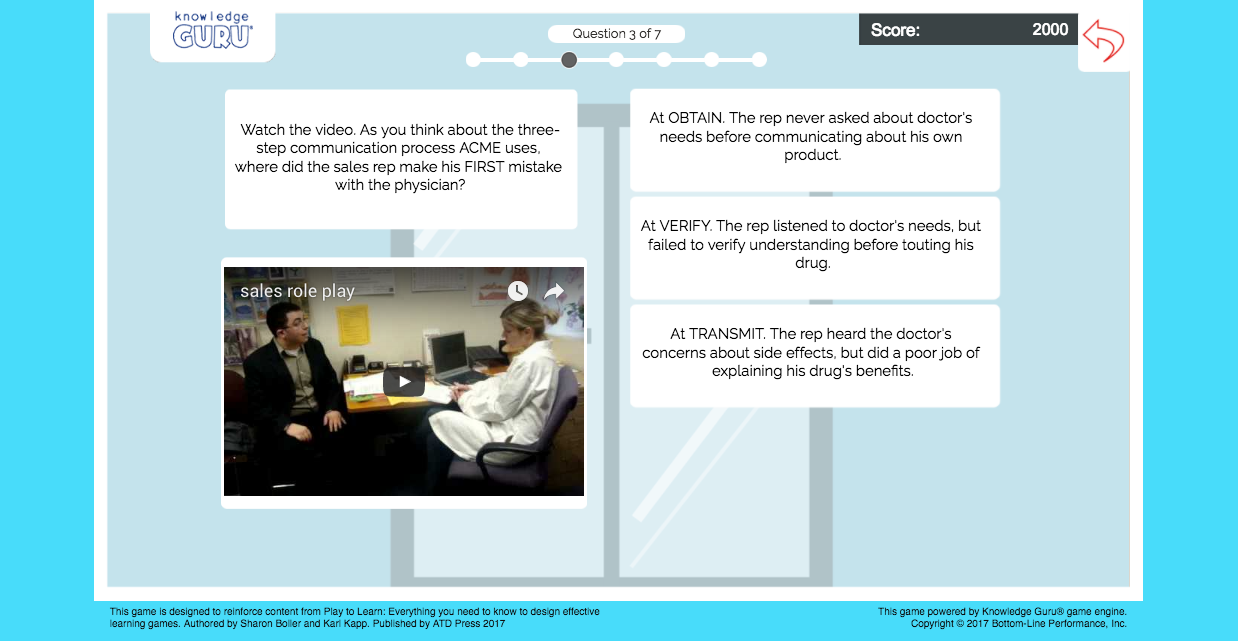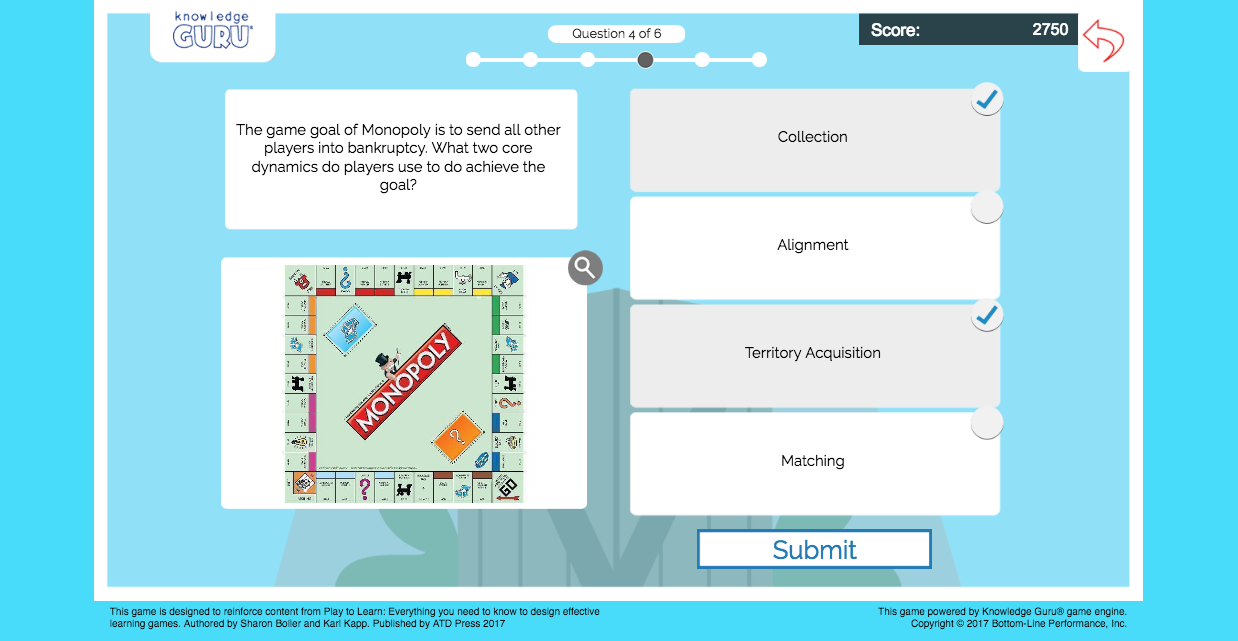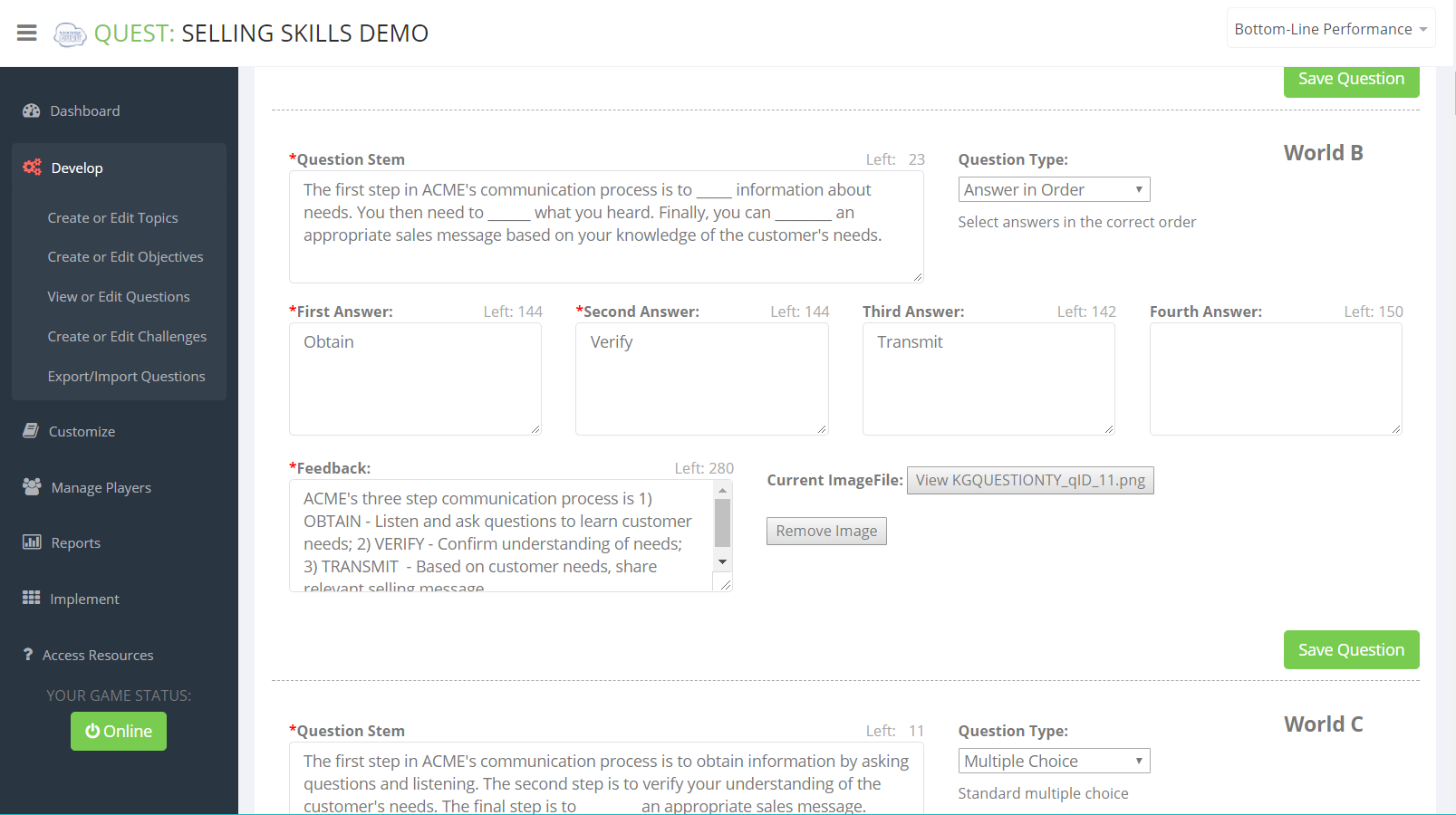Question Types Available in Quest
The kinds of questions you can create in Knowledge Guru’s Quest app include “Multiple Choice,” “Select All That Apply,” and “Answer in Order” questions (aka ranking questions). These question types enable you to provide learners with variety and increase the learning power of a Quest game.
Here is an example of each question type and how it looks in the game:
Multiple Choice

This is an example of a Multiple Choice question type in Quest. Learners click one of the rectangles to select an item.
Select All That Apply

This is an example of a Select All That Apply question type in Quest. Learners click in the circle to select an item.
Ranking/Answer in Order

This is an example of an Answer in Order question type. Learners move the response choices around to reflect the appropriate order.
Using Select All That Apply questions
Select All That Apply questions can be easier or harder for learners to do, depending on what cognitive skill the question requires. A simpler question merely asks the learner to recall a set of facts from memory. A harder question forces them to apply a rule or use judgement. The examples below show how you can use this question type to address different cognitive skills that range from “comprehension” all the way up to “evaluation” on Bloom’s Taxonomy of Learning.
Knowledge/Comprehension (lowest level of Bloom’s taxonomy)
You want learners to be able to identify or recognize something or distinguish one thing from another thing – and you want them to do this with multiple examples. Here are two examples of questions that match this description. To be successful in answering either of these examples, the learner must distinguish the good examples from the poor or irrelevant ones:
- Select all the questions that might be appropriate to ask a customer who is focused on quality.
- Select the cues that might indicate a customer’s need is quality versus price.
Perhaps you need for learners to identify multiple attributes that are all associated with a single item or category. Features versus benefits is a terrific example of when this might be true. Product benefits often are supported by two or more product features. A sales model typically contains multiple steps. A Select All That Apply question helps you verify that learners at least recognize the things that are part of a whole. Here are two examples:
- Select the features that support “ease of use” of ACME’s product.
- Identify the three steps of the ACME sales model.
Higher Levels of Thinking: Application and Evaluation
You can also write Select All That Apply questions that move higher up on Bloom’s taxonomy to let learners apply something (a policy or a rule, for example). Here are two examples that fall into this category:
- Click the Resource link to review ACME’s personal leave policy. Then review the four leave requests and select those that fall within the policy guidelines. (Learners must be able to correctly apply the leave policy to specific situations as opposed to only recalling facts about the leave policy.)
- “It’s” is a contraction. “Its” is a possessive. Review the sentences and select the ones that correctly use “it’s.” (Learners must be able to apply the grammar rules related to “it’s” versus “its”.)
You can also use Select All That Apply questions to push learners to the highest level of Bloom’s taxonomy. Imagine that you need learners to be skillful in interpreting data and using it appropriately in a sales situation. Or imagine that you want to help a sales manager build coaching skills. Here’s how you might write a question to support those skills:
- Review the chart comparing Customer X’s sales to Customer Z’s. Then select all the conclusions you can reasonably discuss with Customer X about how they compare to Customer Z.
- Watch the video and decide which areas of the sales model the sales rep needs coaching on to improve performance.
Using Answer in Order questions
What’s most important versus what’s least important? Quest’s Answer in Order (aka ranking question type) pushes learners to decide. Ranking questions are good ones to use when you want learners to apply judgment to a particular situation based on the specifics of that situation. Here’s an example:
- Watch the video. Your sales rep mishandles several areas of the sales call. However, you know you have to focus your coaching on one or two areas at a time. Given that, prioritize the coaching needs listed below from most important to least important.
An Answer in Order question can also be useful to verify that learners can recall the correct sequence of action within a process or procedure. For example, if you are verifying that employees understand safety procedures, you may want them to demonstrate recall of the sequence in which emergency steps need to occur. You might craft a question like this:
- You find your co-worker unconscious in her cubicle. No one is around to help you. Put the following emergency responses into the correct sequence you need to follow.
Creating Question Types in Quest
As part of question creation in Quest, game authors can select which question type they want to create. The default type will be “Multiple Choice,” but authors can click the drop-down to reveal the other two options.
If you opt to create a Select All That Apply question, you’ll see the screen adjust to allow you to identify which response options a learner should select.
If you select Answer in Order question type, you’ll see that the ranking order is specified as shown below:
Things to know:
- You can have a maximum of four items for learners to evaluate in a question type.
- You can have as few as two items for a question type, but we recommend that you always have four.
- Knowledge Guru’s engine randomizes responses on your behalf each time the learner sees the question. So if learners make a mistake the first time they respond to either of these question types, they will see the response options in a different order when they go back to re-try answering the question.








